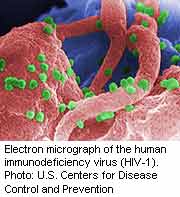- See What Saffron Can Do for Sleep and Heart Health
- 6 Common Mistakes to Avoid Before Your Physical
- Can Sweating Really Help You Beat a Cold?
- Strengthening Your Relationship: Practical Strategies
- Skip Storing This Everyday Product in the Fridge Door
- Green Tea + B3 Pairing May Boost Brain Health
- Navigating Your Midlife Crisis: Embracing New Possibilities
- City Raccoons Showing Signs of Domestication
- Mapping the Exposome: Science Broadens Focus to Environmental Disease Triggers
- One Week Less on Social Media Linked to Better Mental Health
New Clues to How Long-Term Drug Therapy Keeps HIV at Bay


A new study suggests that the replication of HIV may slow or stop altogether in patients who are on long-term treatment, although remnants can still lurk in the body.
And the researchers now suspect that the virus is especially weak in those people who started treatment immediately after becoming infected.
The study is very small, involving just eight patients. However, the findings add more evidence to the debate over how soon patients should begin drug treatment after they’re diagnosed as being infected with HIV. One of the study authors is ready to say that treatment must begin immediately.
“Patients should be started on therapy as soon as they are diagnosed to prevent the virus from hiding in large numbers of cells,” said the researcher, Sarah Palmer, deputy director of the Center for Virus Research at Westmead Millennium Institute for Medical Research, in Australia. “Diagnosing HIV infection early and initiating therapy immediately is crucial for limiting the number of cells containing HIV.”
While doctors can use drugs to kill the AIDS virus in the body, it’s impossible to eliminate it completely. That means there’s no cure for HIV infection or AIDS, the potentially deadly condition that the virus causes.
But what does the virus do when a patient is on medication — does it keep replicating [making copies of itself] or does it hide? The authors of the new study sought to find an answer by analyzing immune-system cells taken from eight HIV-infected patients. All had been taking anti-HIV drug treatment for years.
This combined drug treatment is known as antiretroviral therapy (ART).
The researchers analyzed the cells and found that drug treatment appeared to stop the virus from replicating — an important finding that suggests a possible weakness. However, HIV didn’t vanish but instead hid in certain types of immune-system cells known as “resting memory T cells.” These cells “remember” how to fight a particular body invader, such as a germ or virus and sit around waiting for it to return.
“These cells can remain dormant for many years even though they are carrying HIV,” Palmer said. “When these cells start to replicate or are stimulated to replicate as part of our normal immune response, they also produce HIV, keeping the virus viable. Essentially, these cells are a ticking time bomb in patients, and once they are ignited they explosively produce HIV.”
This finding confirms previous research showing that the lurking virus is “very stable for years,” said David Schaffer, director of the Berkeley Stem Cell Center at the University of California, Berkeley. “It means that treatments must be developed to directly eliminate this long-lived pool, which is challenging,” said Schaffer, who is familiar with the study’s findings.
However, there’s some good news. The numbers of these cells were smaller in patients who had started treatment soon after being diagnosed instead of waiting until they began to show symptoms.
“Diagnosing HIV infection early and initiating therapy immediately is crucial for limiting the number of cells containing HIV,” Palmer said. “The scientific community must develop better strategies to flush HIV from its hiding place in patients without causing new infections.”
Schaffer agreed. A treatment can’t just halt the virus from growing in the body and wait for the infected cells — the “latent pool” — to die out, he said. “Finding a cure for HIV means that therapies must be developed to directly eliminate the latent pool of virus.”
The study will appear online in this week’s issue of the Proceedings of the National Academy of Sciences.
More information
For more about HIV/AIDS, try the U.S. National Library of Medicine.
Source: HealthDay
Copyright © 2025 HealthDay. All rights reserved.










